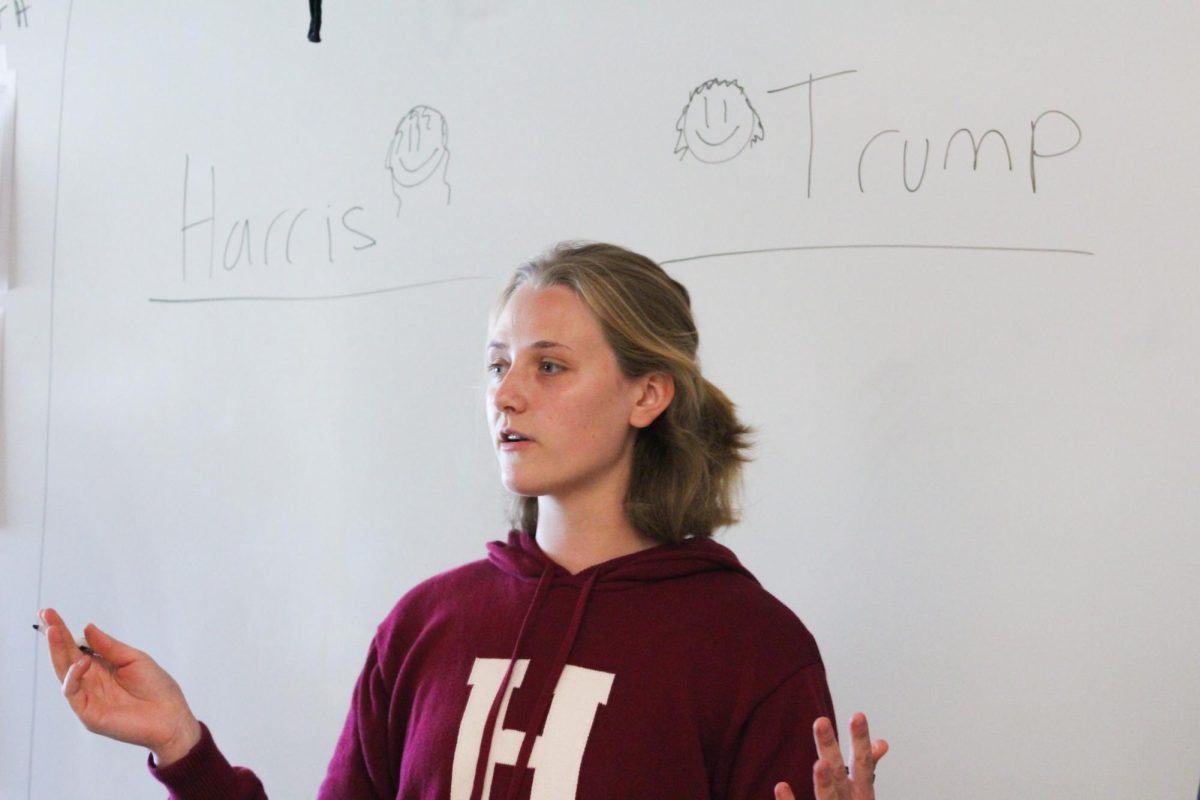It was a beautiful day for admiring architecture in San Francisco. At the top of Divisadero and Broadway, three architecture students — seniors August Truesdale, Maureen McLennon, and Andrew Westle — gazed at a white house with silver-rimmed windows and a stone entrance.

“This is modern done right,” Truesdale said.
Through the eyes of these architecture students, every building in the city is full of life and detail, style as well as error.
This issue, the Bark invited Honors Architecture students to spend an afternoon chatting about some of San Francisco’s most interesting buildings. On the list was the Palace of Fine Arts, homes on Billionaire’s Row, the California Academy of Sciences, and the de Young Museum.
On the column- and tree-lined walkway to the Palace of Fine Arts, the students raved about the site’s beauty.
“It’s a little bit older-themed because it was for the World’s Fair in the early 1900s,” Westle said. “It takes architecture cues from Ancient Rome with the columns and the dome and everything.”
McLennon said that Palace was breathtaking. The dome stands 162 feet from the ground and is 1,100 feet wide. The ornate columns are a rosy orange and stand in pairs around the lighter base embossed with carvings.
Westle said that the columns serve as vertical elements, drawing the eye up to the dome. Truesdale and McLennon noted how the vertical elements make the monument seem more grandiose.
“It’s kind of interesting how if you just drive 30 minutes away the architecture is vastly different,” Truesdale said.
Drive just a little further up Divisadero and it’s the homes that turn into conversation topics. Strolling down Broadway, a street lined with monumental houses and groomed landscapes, the students had something to say about each design, and considered elements they would have added.
At one point, on the corner of Broadway and Broderick, Truesdale pulled out his phone to see where they were. The result? Billionaire’s Row. The students were on one of the wealthiest neighborhoods in the country.
Truesdale praised many of the houses, and said that he’s found that architecture is all about balance between functionality and aesthetics.
“Some buildings look great on the inside but they don’t flow well, and others flow well but they’re just like a box and really boring,” he said. “So as an architect, the greatest challenge is to find an equilibrium. I think that’s what every architect looks for, trying to find a balance.”
McLennon said that she’s always been fascinated by houses.
“I prefer houses. I prefer designing them because I want to design for something that I would want to live in,” McLennon said. “For whatever reason, I’ve always thought houses were beautiful. I’ve always been drawn to them.”
Over the summer, McLennon enjoyed an internship at the Belvedere-Tiburon Landmarks Society chronicling historical houses in the Bay Area.
All three said that their interest in buildings began at a young age playing with Lincoln Logs.
“I’ve always liked building things, even when I was younger, out of wood blocks and Legos,” Westle said.
The third stop on the city tour was the California Academy of Sciences, designed by McLennon’s architecture hero, Renzo Piano.
Westle was particularly interested in the living roof, and how it served both functional and aesthetic purposes.
“As an architect, you think about features like that,” Westle said. “It’s the little things.”
McLennon said one of the challenges of architecture is designing for specific clients, and she’s glad architecture teacher Richard Esteb has emphasized this in his class.
“One thing I’ve always liked about the requirements that we get from Mr. Esteb is he always is really specific about who the clients are, which I think is realistic because as architects, you’re not just going to dream up whatever you want, you have to think about what the client wants,” McLennon said.
She said that this also poses a challenge for designing public buildings like the Academy of Sciences and the de Young.
“With a public space you have to design for everyone, not just for a family or a certain few people,” McLennon said. “There are so many considerations and also the large scale makes it much more difficult because there are only so many thing you can do with it, whereas with a house you can do so much more creatively.”
As he walked around the outside of the Academy, Truesdale praised Piano’s attention to detail. He said that a nice challenge is to find the right combination of traditional and modern elements. The stone wall at the Academy is traditional, he said, but the overhang and the hundreds of small rectangular windows are a modern touch.
“It seems a little bit simple, but there’s so much complexity and so much thought that went into it,” McLennon said. “To the trained eye, you can really notice how much attention to detail there was.”
McLennon looked to her left and compared it to the de Young, which is all parts modern and no parts traditional. McLennon and Westle said that although the de Young isn’t as aesthetically pleasing as the Academy, it suits its function as an art museum.
“It’s not a very pretty building, I’ll give you that,” Westle said. “But I like the statement that it gives as an art museum and how you can see the tower and how it’s covered in this weird copper material. It’s more of a sculpture than a building.”
Truesdale had a different opinion.
“I like it because it incorporates the environment as part of the building and the whole exoskeleton,” Truesdale said. “The exoskeleton, it’s either corten steel or its like a copper-steel combo, and over time, it rusts naturally, and that way when it rains and when it evaporates onto the steel it will eventually turn like a nice green color. It started out as like a bright red and eventually it will turn into an off-green.”
Despite their differing opinions, all three plan to pursue either architecture or engineering in college.
Truesdale plans on getting a business undergraduate degree from Boulder and then a master’s degree in architecture. Westle is planning to major in engineering at UC Davis and McLennon is planning to study architecture and international studies at the University of Washington.












